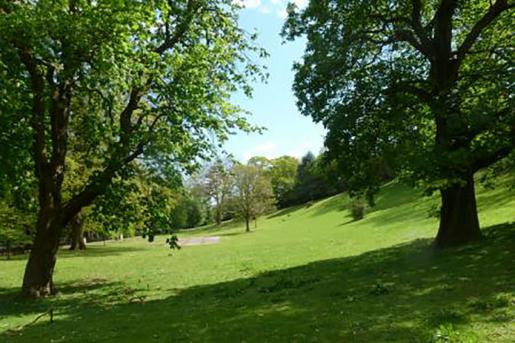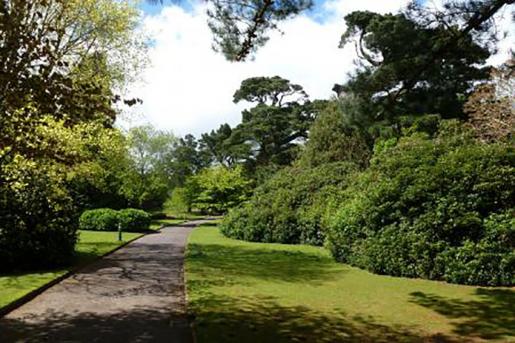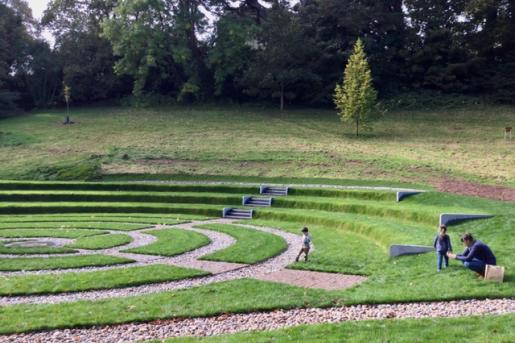- Public Park
- C19
The Knowle was one of the most famous houses in Sidmouth in the nineteenth century but later rebuilding has not left any recognisable early features. Part of the fine grounds remain as a public park.
The Knowle was the headquarter offices of East Devon District Council until a few years ago when the Council decided to relocate to purpose-built new offices in Honiton, financed by the sale of The Knowle to a developer. The Council’s original proposal was to build on a substantial area of the valuable parkland of The Knowle. But after strenuous objections from the townsfolk of Sidmouth and The Devon Gardens Trust, the area for new development was restricted to the site of the rather mundane headquarter office buildings. Following the sale of the Council’s old office buildings to the developer the historic parkland was transferred to Sidmouth Town Council as part of the Sidmouth Arboretum.
The once renowned cottage orne was built in 1810 under the personal supervision of Lord L.E. Despenser and subsequently rented to the Marquis of Bute. It was owned by the collector and connoisseur T.L.Fish from 1836 to 1861 who added picturesque improvements. He also brought exotic trees and plants, animals and birds to the gardens, and on fine Mondays he would open his Marine Villa to the public. In 1850 it was stated that ‘the delightful marine villa is an elegant and tasteful residence surrounded by about 11 acres of ground,divided into lawns, gardens, and conservatories, containing rare and choice specimens of botany, as well as many fine specimens of foreign birds and animals.’ Massive rebuilding and conversion in 1882 into a hotel diminished its architectural qualities,leaving little of its early features. White (1850) noted that it was ‘the delightful marine villa of T.L.Fish Esq. This elegant and tasteful residence is a thatched quadrangular building, of one story, containing about 30 rooms and surrounded by about 11 acres of ground, divided into lawns, gardens, and conservatories, containing rare and choice specimens of botany, as well as many fine specimens of foreign birds and animals.’ Stockdale described it as ’one of the most enchanting places of this kind imaginable, is not only delightfully situated but contains an unparalleled variety of the most rare and costly articles of taste. Although the building is style a cottage orne, both the exterior and the interior have been completed with much taste, the former having a verandah three hundred and fifteen feet ionlength, with supporters covered with roses, myrtles and flowering shrubs so judiciously arrange as not to intercept the view of the sea….. much taste has also been displayed in the arrangement of the surrounding plantations….The House and Grounds are open to the inspection of Visitors’.
The original Lodge still marks the entrance to The Knowle and some garden structures - the Gothic arch, the footings of the grotto and the flint Gothic summer house survive in the gardens of the C20 houses in Knowle Drive.
A substantial area of the original parkland remains, containing some magnificent trees: Cedar, Wellingtonia and Monterey pine. These mature trees are covered by a TPO made in 1956 by Sidmouth Urban District Council, which gives protection to the mostimportant trees on the site.The parkland of The Knowle forms part of the attractive approach to Sidmouth, providing an important contribution to the overall historic character and landscape of the town.
In 2019 the Devon Gardens Trust were consulted on a planning application at The Knowle, for a “flood alleviation scheme comprising a drainage swale and grassed amphitheatre designed to attenuate surface water runoff and provide a venue for public events.” The Devon Gardens Trust has always been keen to encourage good modern landscape design and so gave its full support to the proposal, particularly as the new amphitheatre is a considerable improvement on the incongruous hard standing performance area, left over from the glory days of the Sidmouth International Folk Festival.
Cherry & Pevsner: The Buildings of England – Devon, 1989: 740-1
S Pugsley: Devon Gardens – An Historical Survey, 1994: 163-164
T Gray: The Garden History of Devon, 1995: 135-137



